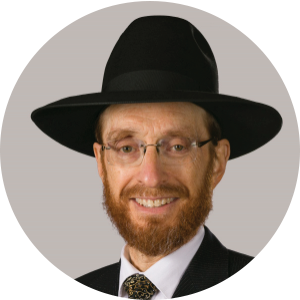Rav Shimon Schwab and the Magic Glue

It can help any parents looking for a magic glue to keep their children engaged at the Shabbos table
T
hey weren’t really “survivors,” but my dear in-laws, Hachaver Rav Shlomo and Rivka Ferber, a”h, were most definitely refugees, having escaped Germany just weeks before the outbreak of World War II. Both came to England, where they were later introduced and eventually married — in London, during the height of the German bombing raids.
After the war, the childless couple immigrated to New York in search of better parnassah opportunities and better mazel. Baruch Hashem, both aspirations were achieved as my father-in-law found steady shomer Shabbos employment and the couple were blessed with three children, one of whom became my wife.
Initially, the Ferbers settled in midtown Manhattan. When the neighborhood changed, they moved to Washington Heights and became members of a local shtibel and the Breuer’s Kehillah.
One Pesach shortly after we married, my wife and I spent the last days of Yom Tov with my in-laws. At the seudah on Leil Acharon shel Pesach, my father-in-law launched into one of his favorite conversation topics: life in prewar Poland and Germany during the Third Reich. As much as he relished sharing his reminiscences, my mother-in-law felt such talk was un-Yom-Tov-dig, since it brought back unpleasant memories of stressful times. And she tried, not so subtly, to change the subject. Their minor difference of opinion remained with me the next day when my father-in-law invited me to join him for “Matnas yad.”
“Matnas yad” is a phrase in the special Mi Shebeirach recited by the rav in German Jewish kehilos on those days before Mussaf on behalf of all the members. The minhag of Matnas yad, which takes place in the afternoon of Shemini Atzeres and the last days of Pesach and Shavuos, is when all members of the kehillah come to the rav’s home in a dramatic display of kavod haTorah to thank him for his Mi Shebeirach.
Although I was not a member of the kehillah, I was eager to meet Rav Shimon Schwab ztz”l, who was considered the dean of the American rabbinate at the time, and whose 25th yahrtzeit we just marked last week.
I accepted my father-in-law’s invitation and walked with him to Rav Schwab’s home.
We arrived together with about a dozen other kehillah members just as an almost equal number were leaving the Rav’s second-floor apartment. We took the just-emptied seats in a large semicircle facing Rav Schwab.
At first, no one spoke. It appeared to me as if the visitors were waiting for Rav Schwab to begin just as he was waiting for them. Eager to seize this golden opportunity, I gently nudged my shver and whispered, “This would be a good time to ask the Rav your question from last night.”
“What question from last night?” he whispered back.
“About whether or not it’s appropriate to speak about the war on Yom Tov,” I replied.
My father-in-law was not the type to make himself the focus of attention. With a bit more coaxing from me, however, he agreed this was an opportunity not to be missed.
“Some people say,” my father-in-law began, tactfully concealing the origin of his question, “that it is inappropriate to speak of wartime experiences on Yom Tov. What is the Rav’s opinion on that?”
“Mr. Ferber!” Rav Schwab intoned in his deep, slightly German-accented voice. “If you do not speak on Yom Tov about the chasdei Hashem you witnessed, when else should you speak about them?!”
He then regaled those present with the following personal account.
“I still vividly remember when I escaped, during the height of the war. I was on a train to Switzerland with forged travel documents. The train approached a trestle over a deep valley that marked the border between Germany and Switzerland. The train stopped on the German side, allowing Nazi officers, yemach shemam, to board the train and check everyone’s papers. As they slowly made their way down the aisle, my heart was beating so hard I was afraid it could even be heard. When they came to me, I tried to appear as calm as possible, even though I knew that if any small detail was not in order, they would arrest me on the spot.
“After what seemed like forever, they returned my papers to me and made their way out. The train then continued on and passed over the trestle into Switzerland. Now, every Shabbos and Yom Tov, I recall the feeling I had then, which fills my heart with gratitude to the Ribbono Shel Olam, as I recite the words in Nishmas, ‘U’mibeis avadim pedisanu!’
“Mr. Ferber, Yom Tov is the ideal time to share with your family the stories of your own salvation. It is a time when we are supposed to gather with our loved ones and recount all the chasdei Hashem we experienced in our lives.”
It was time for all of us to wish the Rav a gut Yom Tov and leave, making room for the next wave of kehillah members who had just arrived and needed places to sit. On our way out of the Rav’s apartment, my father-in-law received the well-deserved words of appreciation from those who had been privy to Rav Schwab’s riveting personal revelation.
Baruch Hashem, most of us do not have wartime stories to share with our families. We all have examples, however, of chasdei Hashem in our own lives that we can recall and repeat on Yom Tov, as Dovid Hamelech declared, “Zeicher rav tuvecha yabi’u” (Tehillim 145:7). And the power of telling those stories to enhance our Shabbos and Yom Tov seudos must not be underestimated, as the following clinical case example illustrates.
Chani (not her real name) was a 40-something speech therapist with six children who had suffered significant trauma as a child. Struggling with recurring bouts of depression and a disappointing marriage, Chani sought help from my dear friend and colleague, Rabbi Yaakov Salomon. After about a year of individual therapy, Yaakov called me with a somewhat out-of-the-box proposal.
“I’m treating a woman who’s been through an awful lot in her life,” Yaakov began. He gave me more background information and then added, “Her husband is clueless and unable to give her or their children what they need emotionally. They have one child off the derech and at least two others who are seriously at risk. She’s depressed, desperate, and needs some help calming the chaos, especially on Shabbos.”
“How can I help?” I asked.
“I want you to see her and her husband to give them some concrete advice to help them manage their Shabbos table. I know that’s not really therapy. But that’s what they need now.”
“So why don’t you see both of them yourself?”
“I’ve been working with her for over a year and he wouldn’t trust me. They have to see someone else whom the husband will trust. And if they don’t get a handle on their Shabbos table, I’m worried that might push her over the edge.”
I agreed to see the couple. And when I met Chani and her husband, Dovid, I learned that the situation was even worse than Yaakov had described. The children who went to shul did not go with their father and came home before him. Then they usually took food for themselves, with each one eating alone. Chani sometimes ate with one child or another and other times joined her husband. Dovid always sang zemiros himself and seemed oblivious and/or helpless to address the fractured family dynamics.
I asked Chani and Dovid what they wanted to work on with me. After describing the typical chaotic scene in their home on Shabbos, they asked if I could advise them on how they could keep at least some of their children at the Shabbos table for at least part of the seudah each week.
I asked if they had a room at home that could be locked from the inside. The only room that fit that description was their bedroom. I asked if they could set up a table there for their Shabbos seudah. They both snickered at the thought. Chani broke into a broad smile and said she kind of liked the novelty of conducting the seudos there.
“Great!” I enthused. “Now here’s what I want you to do. Tell your children that anyone who is not at the seudah when Tatty makes Kiddush will not be allowed in. And then inform them that one of you, alternating each week, will be telling a true story from your childhood after the first course. And only those who are attending the seudah will hear it. Children of all ages are fascinated by stories about their parents when they were younger. Let’s see if this treat is sweet enough to attract them.”
The following week, Chani and Dovid could not wait to report that the story-telling strategy was more successful than they could have ever imagined. Even their off-the-derech son could not contain his curiosity and showed up for the seudah just to hear the story. We then spent the next few weeks tweaking this approach. And when we ended, Chani and Dovid both agreed our work had been a real game changer.
If this strategy worked for Chani and Dovid, it can help any parents who are looking for a magic glue to keep their children engaged at the Shabbos or Yom Tov table. The afikomen helps at the Sedarim. But other tactics are needed for the rest of the seudos.
“Okay, everybody, now it’s time for the story. Once, when I was in seventh grade….”
Dr. Meir Wikler, a frequent contributor to this space, is an author, psychotherapist, and family counselor in full-time private practice with offices in Brooklyn and Lakewood, New Jersey. His latest book, Behind Closed Doors: Over 45 Years of Helping People Overcome Their Challenges, was recently published by Menucha Publishers.
(Originally featured in Mishpacha, Issue 803)
Oops! We could not locate your form.













